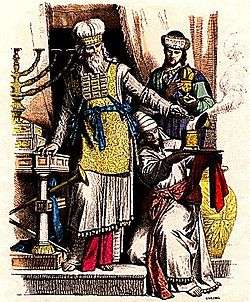Priestly sash
| Part of a series of articles on |
| Priesthood in Judaism |
|---|
| |
|
Kohen · Recognition of priestly descent Priestly covenant |
|
Aaron · Eleazar · Phinehas · Eli · Ahimelech · Abiathar (First Temple) · Zadok · Shallum · Hilkiah · Jehoiada (Second Temple) Joshua the High Priest Simeon the Just Yishmael Ben Elisha Yehoshua ben Gamla Pinchus Ben Shmuel |
|
The ten gifts given in the Temple 1. Sin offering · 2. Guilt offering 3. Communal peace offering 4. Fowl sin offering · 5. Leftovers from the suspensive guilt offering 6. Oil from the offering for the leper 7. Bread from First Fruits · 8. Showbread 9. Leftovers of the meal offering 10. Leftovers of the First Sheaf.
15. Heave offering 16. Heave offering of the Levite's tithe 17. Dough offering 18. First shearing of the sheep 19. Shoulder, cheeks and maw 20. Coins for redemption of the first born son · 21. Redemption of a donkey · 22. Dedication of property to a priest · 23. Field not redeemed in a Jubilee year · 24. The property of the foreigner with no heir. |

Hebrew Bible
The priestly sash or girdle (Hebrew avnet אַבְנֵט) was part of the ritual garments worn by the Jewish and priests of ancient Israel whenever they served in the Tabernacle or the Temple in Jerusalem.
The "sash" or "girdle" worn by the High Priest was of fine linen with "embroidered work" in blue, purple and scarlet (Exodus 28:39, 39:29); those worn by the priests were of white, twined linen. The sash should not be confused with the embroidered belt of the ephod. Like the other priestly vestments, the purpose of the sash was "for glory and for beauty" (Exodus 28:41). On the Day of Atonement the High Priest changed into special linen garments that included a sash of fine linen without any embroidery (Leviticus 16:4). These linen garments were worn only once, with new ones being made each year.
Rabbinical commentary
According to Rabbinical literature, Midrash and Maimonides, the sash was 32 cubits long and 2, 3 or 4 fingers wide.[1] At this length, it would have to have been wound around the body several times. Theories differ as to how this was accomplished: some say it was wound around the waist only, while others say it was wound around the waist and over the shoulders, crossing over the heart. In any event, the ends would have been tied and allowed to hang down in front. According to the Talmud, the wearing of the sash atoned for "sins of the heart" (impure thoughts) on the part of the Children of Israel (B.Zevachim 88b).
References
- ↑ Maimonides; Kadmoniyot _____page? ____edition?